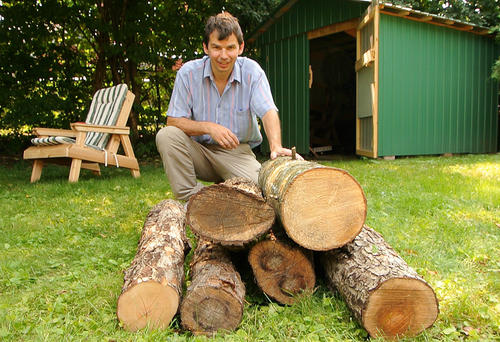
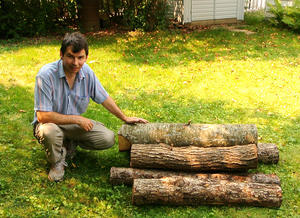 I obtained a few logs from trees cut down in my neighbourhood. Some walnut, red oak, a pear tree,
and some spruce, just for a test.
I obtained a few logs from trees cut down in my neighbourhood. Some walnut, red oak, a pear tree,
and some spruce, just for a test.

 I obtained a few logs from trees cut down in my neighbourhood. Some walnut, red oak, a pear tree,
and some spruce, just for a test.
I obtained a few logs from trees cut down in my neighbourhood. Some walnut, red oak, a pear tree,
and some spruce, just for a test.
Setting up the mill. I drew up a better log bed in the plans based on previous experience, but I had never actually built it like that myself. So time to test that design.
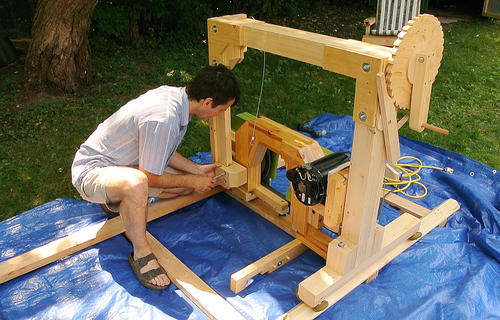
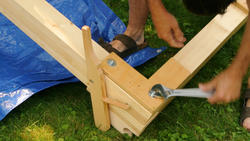 It's a lot of work setting it up, because a lot of stuff needs to be assembled.
It's a lot of work setting it up, because a lot of stuff needs to be assembled.
I put the big 2 HP motor on it again. I only use that motor for milling.
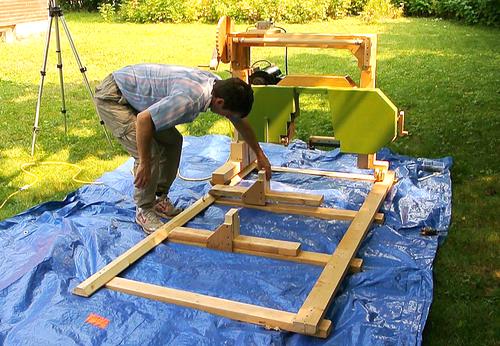 These are the log holders, or log dogs, that I wanted to try out. Holding the logs
firmly enough has always been a problem.
These are the log holders, or log dogs, that I wanted to try out. Holding the logs
firmly enough has always been a problem.
These log holders just fit on the crossbeams (or rungs) of my log bed, only held in place by gravity.
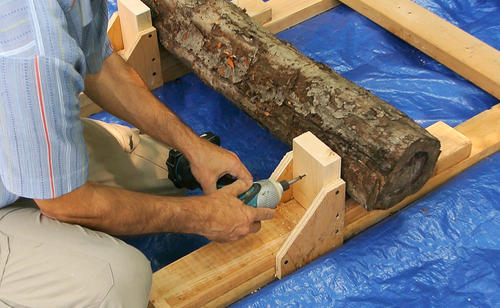 The log is attached on just one side with wood screws.
The log is attached on just one side with wood screws.
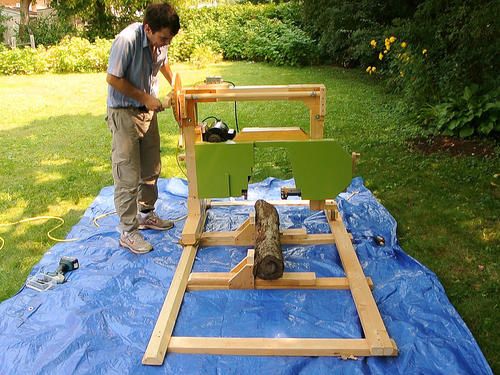
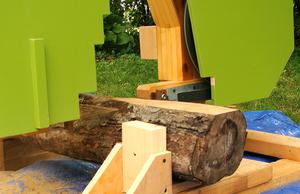 The log holders were very effective at holding the log steady. But when cutting oak, I was still
getting oscillating in the mill. My sawmill is just not stiff enough. A solution would
be to build everything much heavier, but that would also make it less portable.
The log holders were very effective at holding the log steady. But when cutting oak, I was still
getting oscillating in the mill. My sawmill is just not stiff enough. A solution would
be to build everything much heavier, but that would also make it less portable.
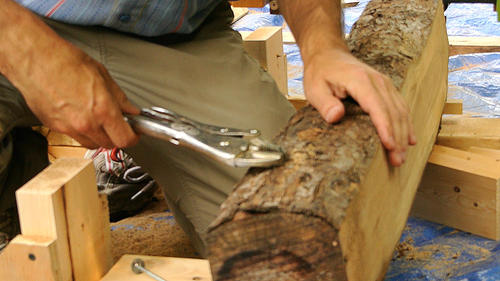 What didn't work so well was my favourite type of screw —
drywall screws. I broke the head
off one of them. I unscrewed the rest of the screw with vise grips, then switched
to "proper" wood screws, which didn't break.
What didn't work so well was my favourite type of screw —
drywall screws. I broke the head
off one of them. I unscrewed the rest of the screw with vise grips, then switched
to "proper" wood screws, which didn't break.
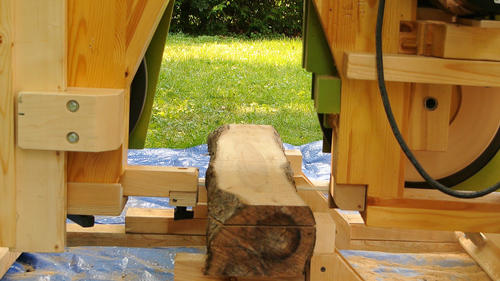
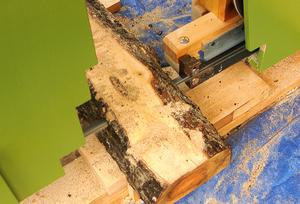 Cutting a small walnut log. Mostly sapwood, so I'm not sure if it's good for anything.
Cutting a small walnut log. Mostly sapwood, so I'm not sure if it's good for anything.
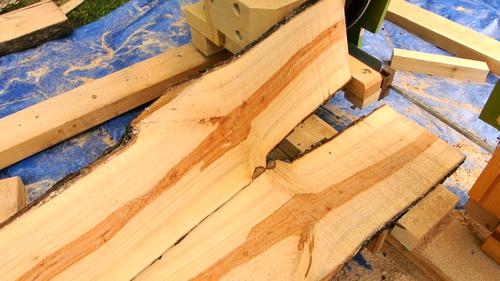 The pear logs I milled came out very nice though. And the pear wood mills like butter.
The pear logs I milled came out very nice though. And the pear wood mills like butter.
An artist I met in Germany said he uses only pear tree for his wood cuts. I can see why. The pear is a very smooth, and easy to work, with almost no grain.
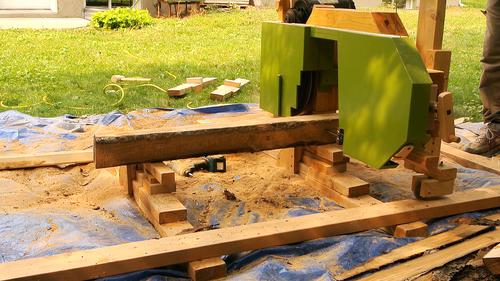 Another small log. I squared this one up, then sliced it in the middle.
Another small log. I squared this one up, then sliced it in the middle.
The log was a bit too small for my log holder, so I stacked some blocks under it to get it to the right height.
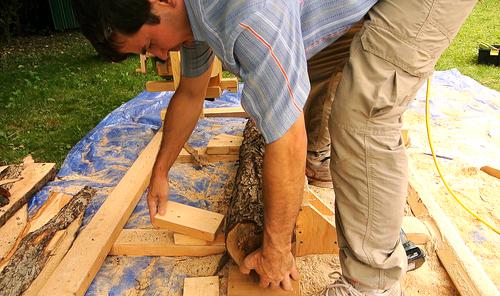 Another log, stacking blocks under it. Once the log has two flat sides, gravity is enough to
hold it in place, so I could just bring the log up gradually by putting more blocks under it.
Another log, stacking blocks under it. Once the log has two flat sides, gravity is enough to
hold it in place, so I could just bring the log up gradually by putting more blocks under it.
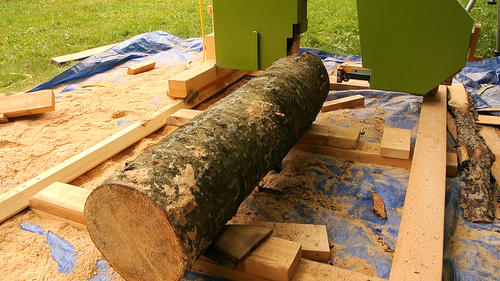 My final log was the spruce log.
My final log was the spruce log.
I never intended this mill to be used with coniferous trees. Coniferous trees are dry and sappy, so some sort of detergent soap drip system is usually employed to keep the blade from gumming up and keep it cool. But my mill is made of wood, with MDF wheels. So I'm not keen on getting it wet.
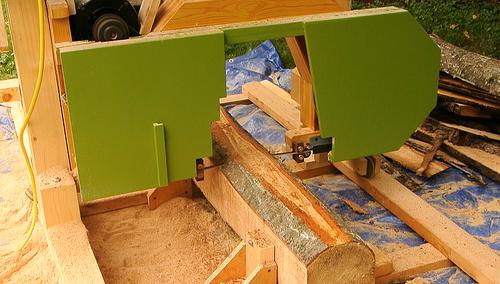
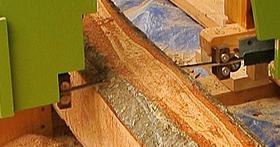 I was starting to get blade drift issues again. I'm amazed how much abuse that bandsaw
blade is able to take!
I was starting to get blade drift issues again. I'm amazed how much abuse that bandsaw
blade is able to take!
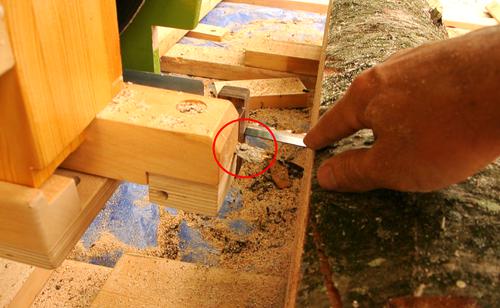 Every time I have had drift problems with this mill, the blade drifted up.
I experimented with tilting the first blade guide downwards a bit by putting shim in it,
and for the first time, I got the blade to drift down.
Every time I have had drift problems with this mill, the blade drifted up.
I experimented with tilting the first blade guide downwards a bit by putting shim in it,
and for the first time, I got the blade to drift down.
If I ever build another sawmill, it's tempting to make a tilt-adjustable guide. But a wider blade, and especially wider wheels with a shallower crown on them would probably also help to get the blade aligned better for less drift.
In my experience, once I have one of my upright bandsaws properly set up, there is no need for drift adjustment on the fence.
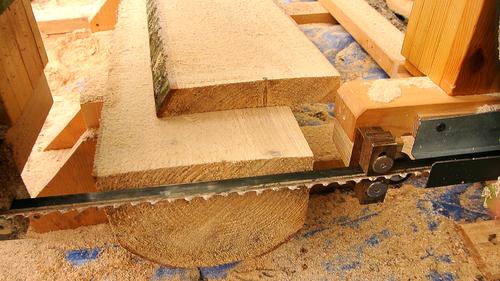 The mill was really struggling with the spruce, the blade and the thrust bearing were
getting quite hot. There were also a lot of wood fibers stuck to the blade.
It really wasn't designed for softwoods. I was ready to give up on this log when I
took this photo.
The mill was really struggling with the spruce, the blade and the thrust bearing were
getting quite hot. There were also a lot of wood fibers stuck to the blade.
It really wasn't designed for softwoods. I was ready to give up on this log when I
took this photo.
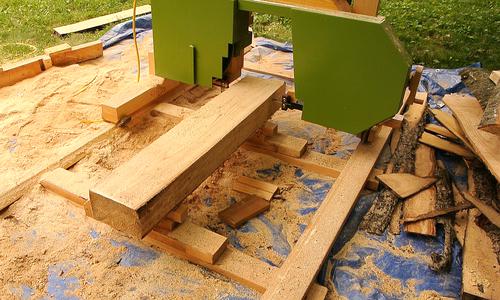 But I figured, maybe just a bit more. This time, I pushed harder on the feed and,
surprisingly, cutting faster worked better. Maybe the teeth on the blade were
getting too dull to effectively hook onto the fibers with the lower feed rate.
But I figured, maybe just a bit more. This time, I pushed harder on the feed and,
surprisingly, cutting faster worked better. Maybe the teeth on the blade were
getting too dull to effectively hook onto the fibers with the lower feed rate.
The 2 HP motor didn't slow down a bit, so I think I still had power to spare.
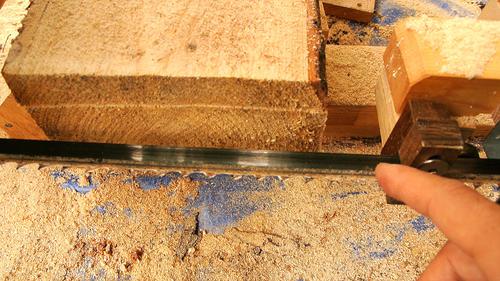 With the higher feed rate, some of the fibers even cleared off the teeth on their own.
So maybe this would work without lubrication. But I suspect sap buildup on the blade
would be a problem eventually.
With the higher feed rate, some of the fibers even cleared off the teeth on their own.
So maybe this would work without lubrication. But I suspect sap buildup on the blade
would be a problem eventually.
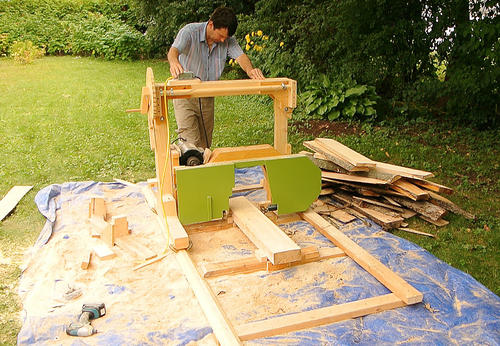 Last cut. I'm using two really shallow log holders to hold the final slab as I cut it in half.
Last cut. I'm using two really shallow log holders to hold the final slab as I cut it in half.
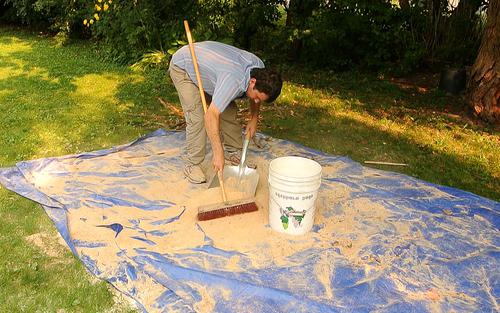 The tarp on the ground really made cleanup easier. Getting sawdust out of the grass
is really hard. But I should have set the sawmill up closer to one edge of it, because
it really shoots out the dust on one side, especially as I was motoring through the
spruce. I only made a bit more than one five-gallon bucket of sawdust this time,
not as much as last time.
The tarp on the ground really made cleanup easier. Getting sawdust out of the grass
is really hard. But I should have set the sawmill up closer to one edge of it, because
it really shoots out the dust on one side, especially as I was motoring through the
spruce. I only made a bit more than one five-gallon bucket of sawdust this time,
not as much as last time.
The bandsaw that I use for the mill is the bandsaw I use the least often. Before using it to build a lawn chair, I hadn't used it for 14 months straight! But it gets more than it's share of abuse, and I have made more sawdust with this saw than I have with my other two homemade bandsaws combined!
This time went better than last time, but I have to say, as sawmills go, it's not a particularly good one. For example, see these sawmills I videoed at the Glengarry wood fair.
But I'd rather use mine than chainsaw milling. And it's definitely more effective than pit sawing or squaring logs with an axe!